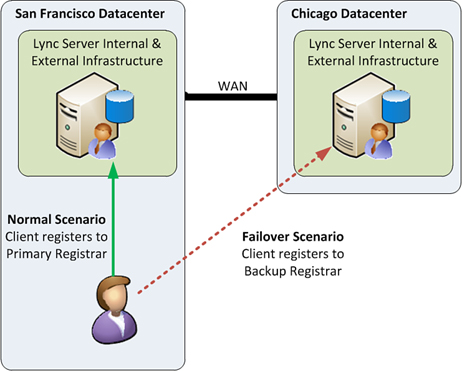Datacenter Survivability
,To provide the failover capability when the primary pool is unavailable, each Front End pool can be assigned a backup pool. This can be another pool in the same site, or more commonly will be a pool in a separate datacenter across a WAN link. Using a separate datacenter ensures the voice services are available in the event of a primary datacenter site failure. When assigned, as clients sign in, they will receive information about which pool is the primary and which pool is the backup. Figure 28.3 shows what happens in a datacenter failover scenario.
Figure 28.3 Datacenter Resilience

Note
Under normal operating circumstances, endpoints use the registrar service located on the primary pool. In the event the endpoint cannot contact the primary pool, it will attempt to contact the backup. If the backup pool determines the endpoint’s primary pool is indeed unavailable, it will accept the registration for the user.
As indicated previously, the backup pool maintains a monitor to check whether the primary pool is available at all times. This monitoring is accomplished through the use of heartbeat messages exchanged between the two pools across a WAN link. Only after the backup pool stops receiving heartbeat messages from the primary will it mark the pool as offline and begin accepting user registrations. The default timeout interval for the heartbeat messages is 300ms, but it can be modified by an administrator if a longer or shorter timeout period is required.
Pools in different sites can serve as backup registrars for each other. For example, Company ABC can have Lync Server 2010 Front End pools in both San Francisco and Chicago. Each pool can serve as a backup registrar for the other so that users will still have voice services through the opposite registrar in the event of a pool failure.
When clients are using a backup registrar service, not all features are available. Features that are available in a failover scenario include
• PSTN Calls—Outbound calls should have no issues, but inbound call availability is dependent on the PSTN carrier service delivering inbound calls to the backup location. The capability for this feature varies depending on location and carrier.
• Internal Calls—Internal voice calls are possible between users in the same site and to additional sites.
• Call Control—Users are able to use basic call features such as hold and transfer. Advanced features such as call forwarding, simultaneous ringing, and team call are also available in a failover scenario.
• Instant Messaging—Instant messaging service is available, but only between two parties. No instant messaging conferencing services are available.
• Audio/Video Calls—Audio and video calls are between two parties only. Audio/video conferencing services are unavailable.
• Call Detail Records—As long as the backup pool is associated with a CDR, collector data is still added.
Features that are unavailable to users in a failover scenario include
• Conferencing Auto Attendant—The dial-in conferencing attendant service and all scheduled meetings with the conference bridge are unavailable.
• Conferencing—Any type of conferencing is unavailable. This applies to instant message, meeting, and audio/video conferences involving more than two parties.
• Presence-Based Routing—Because presence data is unavailable, calls to users homed on the failed pool do not have calls routed around this presence. For example, if a user sets the status to Do Not Disturb, instant message and phone calls are still delivered.
• Call Park—The ability to park calls is unavailable to users homed on the failed pool.
• Response Group Service—Any workflows and queues associated with the failed pool are unavailable. Agents will be unable to sign in.
• Call Forwarding Settings—Although call forwarding capabilities remain in effect during a failover, users are unable to update or change their call forwarding settings.
• Voicemail Delivery—Assuming the users’ Exchange servers were part of a site failure, new voicemail messages cannot be delivered.
• Voicemail Retrieval—Again, assuming the users’ Exchange servers were part of a site failure, voicemail messages cannot be accessed.
Tip
If resilient voice services are required, organizations should plan to designate a backup registrar pool in the event of a primary pool outage. The WAN link between the two pools should be sufficient to support the additional voice traffic and ideally be resilient.
